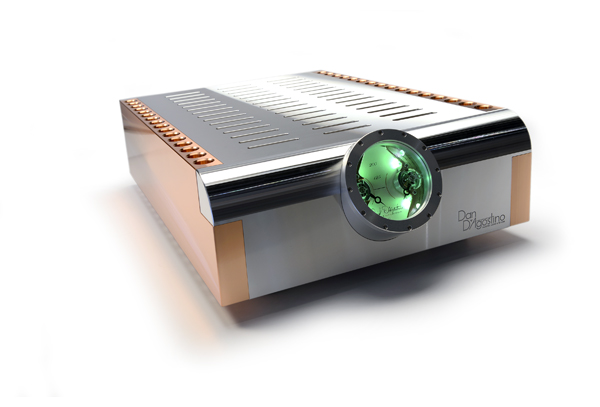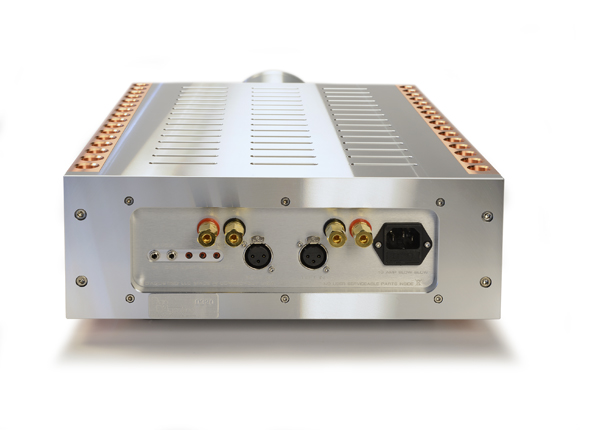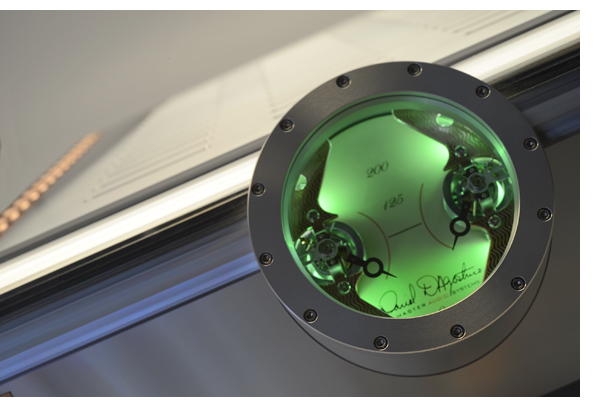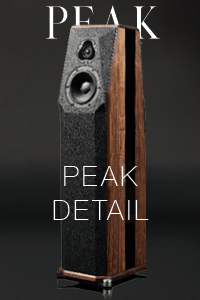 Flanked by the wall of monstrous amplifiers here for evaluation, the compact D’Agostino Momentum stereo power amplifier stands out from the pack. As the Hammond organ solo in Mighty Sam McClain’s “Too Proud” crescendos from the softest touch to full force and back, the sound, awash in texture and decay, takes me to that magical place where I’m truly convinced that I’m not just listening to a hi-fi system; this is real music unfolding in front of me.
Flanked by the wall of monstrous amplifiers here for evaluation, the compact D’Agostino Momentum stereo power amplifier stands out from the pack. As the Hammond organ solo in Mighty Sam McClain’s “Too Proud” crescendos from the softest touch to full force and back, the sound, awash in texture and decay, takes me to that magical place where I’m truly convinced that I’m not just listening to a hi-fi system; this is real music unfolding in front of me.
Even at high listening levels, when pairing the Momentum with my reference KEF Blades, the dual indicator needles of the amp’s sexy lime-green power meter barely come off of their rest stops—and I pause, wondering if perhaps they are defective. This amplifier seems to have an endless reserve of power on tap, along with thunderous but controlled and defined bass response. Remember, this amp is from the same man that gave us Krell amplifiers in the 1980s—amplifiers that redefined what solid-state amplification could achieve.
Luckily, I still have an original Krell KSA-50 on hand for comparison (covered in the Old School column in issue 53), and I enjoy jumping in the time machine to revisit the inception of this mighty amplifier. All of the Momentum’s core attributes are here in the KSA-50. While Krell amplifiers always received much fanfare for their prodigious bass response, the KSA-50 also has a smooth, grain-free top end, with a wealth of inner detail to boot. Comparing these two amps is a lot like comparing an early Porsche 911 to a current model; driving them back to back brings home the level of refinement that’s taken place over the years.
He’s Done It Again
The D’Agostino monoblocks, released about two years ago, caused quite a stir in the industry. Even at $55,000 a pair, they made believers out of everyone who heard them. The Momentum Stereo, priced at $30,000, makes this performance available to a more prudent and space-conscious audience. Best of all, should you decide that the extra juice of the monoblocks is necessary, you can send your stereo amp back to the factory and have it converted to a monoblock. Then just add the second monoblock, which makes for and easy and cost-effective upgrade from the single-amp solution.
At the risk of deterring you from spending more money with Mr. D’Agostino (unless you have terribly inefficient speakers), I will say that you may never need to go with the monoblocks. All of the speakers at my disposal are in a sensitivity range of 86 dB to 90 dB per watt, and no matter how far I crank the volume, I never hear even the slightest hint of compression or clipping. And I do listen to my music fairly loud on occasion.
Going back to the recent LP remaster of ZZ Top’s Tres Hombres, I do just that—and as great as the massive drums and guitars sound through the Momentum, the telltale bit comes at the end of the track, when Gibbons’ guitar gently fades over a bed of wind chimes tinkling in the air. Wow! The incredibly detailed three-dimensional perspective again fools me into thinking I’m listening to an actual musical object floating in space. But the real test comes when I play “Sam the Wonder Dog,” from the first Stereophile test CD, which has the neighbors’ dogs howling away!
We could go on and on about all the technology that makes the Momentum so special—from the unique design of its heat sinks to its two big banks of 69-MHz output transistors—but you can read all of that on the D’Agostino website here.
I should note that our review sample spent time at a few trade shows, so it arrived fully broken in and ready to go, so I can’t comment on how long a fresh amplifier takes to sound like the review sample.
A Sight to Behold
Don’t let the diminutive form factor of the Momentum fool you. This slender amp is all business, weighing nearly 100 pounds. We normally don’t hesitate to pop the top off of most amplifiers, but the Momentum’s case has no exposed screws, so rather than risk a highly embarrassing call to D’Agostino, I decide to settle for pictures of the amp’s gorgeous exterior.
And gorgeous it is. The entire chassis, save for the side-mounted heat sinks (machined from copper billet), is all CNC machined from solid aluminum. Chances are high that you will be spellbound by the refined-steampunk look of the Momentum.
Rocking SBTRKT’s self-titled album brings the listening room alive with major beats that punch you in the stomach, yet the finesse of the Momentum creates a massive ball of sound that feels like multi-channel audio emanating from only two speakers. With the music approaching club volumes, the Momentum’s needles now move in earnest, inching halfway up each side of the power meter—but there’s still plenty of juice on reserve. Again, the KEF Blades crank out heavy, controlled bass that you feel as much as you hear.
Much like the sports cars of the early 1980s, most power amplifiers were one-trick ponies that don’t offer anywhere near the same amount of finesse as today’s best designs. What makes the Momentum amplifier so dandy is that it offers no compromise in any aspect of sound reproduction or even day-to-day use. Thanks to some new power-management circuitry from Mr. D’Agostino, the Momentum only draws one watt when in idle mode—which is less than an iPhone charger!
D’Agostino doesn’t list a spec on power draw at full output, but being a Class AB design (a radical departure in itself for Mr. D’Agostino), this amplifier probably only draws about 500 to 700 watts from the AC line, which means that it doesn’t require anything out of the ordinary in terms of power. After hours of play at relatively high volumes, the copper heatsinks get warm to the touch, but nothing like any of the Class A amplifiers at my immediate disposal.
But again, all the technology under the hood of the Momentum stereo amplifier is lost on this writer the minute that the music begins to play. After months of listening to the Momentum with a plethora of ancillaries, I find it completely without fault of any kind, on any level.
Listening to the hardest rock or the subtlest solo vocalist, this amplifier delivers power, punch and nuance, all with equal aplomb. The best amplification components I’ve experienced make it impossible to identify them with your eyes closed. The Momentum is one of these rare amplifiers that will leave you scratching your head, with a non-existent sound signature that resembles neither tubes nor transistors. The Momentum is in very rare territory indeed.
Grooving on “Twisting with James,” from the Dr. No soundtrack, the drumming stays right in the pocket, while the full-on surf guitar and sax easily occupy their own private space in the soundstage. Cranking both sides of Judas Priest’s Screaming For Vengance on LP usually leaves me desperate for some earplugs, but the Momentum reproduces the layers of driving lead guitars so effortlessly, keeping the voicing of Glenn Tipton and K.K. Downing’s guitar distinctly different. This is something that many amplifiers cannot achieve, especially at high volumes. It’s metal at its finest.
Spinning a pile of Motown records, settling on some Supremes, I find it intriguing to hear how much detail lurks in these classic tunes. The Supremes’ collaboration with the Temptations, “I’m Gonna Make You Love Me,” is fantastic; it not only reveals the vocal stylings of these legendary artists, but it also puts some meat on the bones of the presentation. This tune now has a solid bass line that was not apparent before.
The percussive sounds at the beginning of Tom Waits’ “Town With No Cheer” hang in the air effortlessly, as the bagpipes fade to Waits’ young, vibrant voice, which keeps a subtle distance from the harp and accordion playing in the background. This sense of space is what separates the Momentum from lesser amplifiers, this delicacy again making it so easy for the amplifier to just disappear and become a conduit for whatever music is being played.
While the Momentum definitely benefits from adding premium cable, as does any great amplifier, it is not overly cable sensitive when it comes to power or signal cables. However, its highly resolving nature allows the differences between various cables to come through loud and clear. The Momentum does not prove highly sensitive to the various power-line conditioners on hand, either—a testament to the high integrity of its power supply’s design. The Momentum does experience a slight increase in high-frequency smoothness and liquidity when plugged into either the Running Springs Maxim or the IsoTek Super Titan conditioners (both via a dedicated 20-amp circuit), but this effect is nowhere near the dramatic difference experienced with some even more expensive amplifiers.
Perhaps the only piddly complaint with the Momentum is that, because it’s such a compact amplifier, the rear panel reveals a sparse complement of connectors: 12-volt triggers, a pair of XLR inputs and a pair of copper binding posts that do not allow for banana plugs. It’s all tucked in fairly tight quarters, so those with massive speaker cables may need to rethink their termination. I would highly suggest adding the stylish aluminum base that D’Agostino developed for the amplifier. The base will assist in cooling and get the amplifier up off the floor or shelf, providing much easier access to the speaker terminals.
Around front, the power switch hides underneath the crown jewel of the Momentum, the magnificent power meter, which is backlit in bright green. If there were ever a place that the term “audio jewelry” applied, it’s here. I suspect that this amplifier will be as compelling to look at years from now as it is the day you remove it from its padded flight case.
The day of $30,000 amplifiers is here to stay. While some will whinge about the price, the question remains: Does this amplifier provide performance and build quality in keeping with the price asked?
To that ultimate question, the answer is unquestionably yes. We’ll even stick our necks out and say that the D’Agostino Momentum stereo amplifier is possibly one of the best amplifiers available at any price. If you don’t believe me, I suggest you take one for a test listen.
Momentum stereo amplifier
MSRP: $29,000 (silver); $31,500 (black)
Peripherals
Analog source
AVID Acutus Reference SP turntable TriPlanar tonearm Lyra Atlas cartridge
Digital source
dCS Vivaldi stack
Phonostage
Indigo Qualia
Preamplifier
Audio Research REF 5SE Burmester 011 Robert Koda K-10
Speakers
GamuT S9 KEF Blade Dynaudio Evidence Platinum Focal Maestro Utopia Sonus faber Guarneri Evolution
Power
IsoTek Super Titan
Cable
Cardas Clear
















